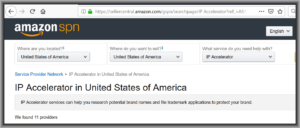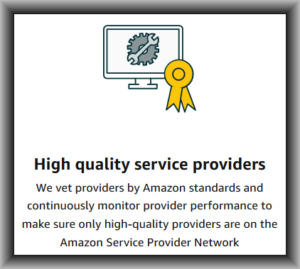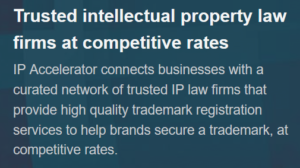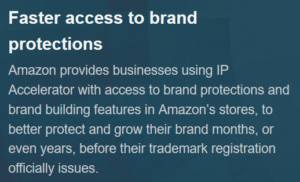
On October 1, 2019, Amazon launched its IP Accelerator service. Through this service, Amazon offers a jump-the-line way for a seller to get into the Amazon Brand Registry. Amazon did not do this well, and Amazon’s actions will likely harm consumers, as I will explain.
To see what is wrong with Amazon’s implementation of its new IP Accelerator service, one must first recall how Amazon implemented its Amazon Brand Registry (“ABR”) service. The idea of ABR is that if you have legitimate trademark rights, you can register them with Amazon in the ABR. You can then do “takedowns” to shut down sellers who are infringing your trademark rights.
Normally the way that you secure a position in ABR is by proving to Amazon that you are the actual owner of a US trademark registration. This involves telling Amazon which particular trademark registration you claim to own, and then Amazon tests this by sending a secret Verification Code to the email address that is on file at the USPTO. The Verification Code, when provided back to Amazon, gives you this very potent “takedown” power in the world’s biggest marketplace, a marketplace that is so massive that some antitrust regulators wonder whether it needs to be broken up, like Standard Oil was a century ago. It is our firm’s email address that is on file at the USPTO for many US trademark registrations of our clients, and we have received many Verification Codes over the years as a consequence. This arises because the client has filed a request with Amazon for ABR status. We forward such a Verification Code to our client who then uses it to secure its ABR status.
The power of a position in ABR is so great that wrongdoers have often gone to great lengths to snag the Verification Code. In a typical heist, the wrongdoer files a Change of Address at the USPTO for the trademark registration (updating the email address on file at the USPTO), then orders up the Verification Code, receives it, uses it to grab the spot for that trademark in ABR, and then changes the email address back at the USPTO, all before the trademark owner figures out that its rights are being hijacked. To read about this ABR hijacking, see my 2017 blog article Is someone tampering with your US trademark registrations? The USPTO has been forced to implement cumbersome protective mechanisms to try to reduce how often a would-be hijacker will succeed in such a heist.
We have had several instances in which an otherwise inexplicable address change has been filed for a trademark file for one or another of our clients, and in each case it became clear that the address change was part of such a hijacking attempt. Fortunately in each case we and the client were able to work together to keep the hijacking from succeeding.
One more thing needs to be mentioned for the reader to appreciate how poorly Amazon has designed its Amazon IP Accelerator program. There are two kinds of trademark applications in the US — use-based and intent-to-use. With an intent-to-use (“ITU”) application, the applicant need not have actually made use of the proposed trademark. Instead, the applicant does nothing more than profess a “good-faith intention to use the mark” at some unspecified time in the future. Under US trademark law, the filer of an ITU application cannot obtain an actual registration certificate until the filer gets around to actually using the mark in interstate commerce, and then provides proof of such use to the USPTO (pursuant to a declaration under penalty of perjury as to the veracity of the proof).
From this it will be appreciated that until recently you could not secure a coveted spot in the ABR until you had actually proffered this proof of use to the USPTO, made the required representations under penalty of perjury, and obtained a registration certificate.
But now comes Amazon IP Accelerator. If you want to skip to the front of the line, you can get into ABR merely by filing an ITU trademark application. But this works only if you file it through one of the eleven trademark firms that are on the Amazon IP Accelerator web page.

How do you get to be one of these eleven trademark firms? Click on “how it works” and you reach a page that helpfully explains:
We vet providers by Amazon standards and continuously monitor provider performance to make sure only high-quality providers are on the Amazon Service Provider Network.

Back on the main Amazon IP Accelerator page, Amazon further explains:
IP Accelerator connects businesses with a curated network of trusted IP law firms that provide high quality trademark registration services to help brands secure a trademark, at competitive rates.

And here’s the jump-the-line part:
Amazon provides businesses using IP Accelerator with access to brand protections and brand building features in Amazon’s stores, to better protect and grow their brand months, or even years, before their trademark registration officially issues.
Yes if you go through one of these eleven trademark firms, you can get “takedown” power in ABR merely by filing a trademark application. You don’t need to have made any pesky statement under penalty of perjury that you ever actually got around to using the proposed trademark in interstate commerce. In contrast, any brand owner who had the bad luck to have filed its trademark protection through any of the thousands of other trademark firms in the US would have to wait “months, or even years” for a registration to officially issue, to obtain this “takedown” power in ABR.
You can read Amazon’s blog post (captured October 29, 2019) about Amazon IP Accelerator. It is written by Dharmesh Mehta (Linkedin page) who is a Vice President of Amazon and is Director, Amazon Worldwide Marketplace Business. Here’s how Mr. Mehta explains it:
Because the participating law firms have been thoroughly vetted, when a business works with one of the law firms in IP Accelerator and a trademark [application] has been filed on their behalf, they will be strong candidates for registration. As a result, Amazon will provide these brands with accelerated access to brand protections in Amazon’s stores, to better protect their brand months, or even years, before their trademark registration officially issues. Brands will benefit from automated brand protections, which proactively block bad listings from Amazon’s stores, increased authority over product data in our store, and access to our Report a Violation tool, a powerful tool to search for and report bad listings that have made it past our automated protections.
You can see the FAQ page (screen capture October 29, 2019) for Amazon IP Accelerator which explains this jump-the-line benefit in detail:
If you file a trademark application through an IP Accelerator law firm, you will be invited to enroll in Brand Registry and have access to the following benefits:
Proactive brand protections: Amazon will use information that you provide about your brand to implement protections that attempt to proactively identify and remove potentially bad listings that could harm your brand and our customers.
Powerful search and report tools: You will have access to the Report a Violation tool that provides text and image based searching capabilities and simplifies the process of reporting potential infringement (e.g., common law trademark infringement) with multiple features designed specifically for brands.
Other brand-building benefits: You will be able to further build and grow your business on Amazon by taking advantage of powerful tools designed for brands such as Enhanced Brand Content product detail pages, Brand Stores, Sponsored Brands, and the Brand Dashboard.
Who are the eleven “thoroughly vetted” firms that can help you “jump the line” to obtain takedown power in ABR without having to actually have any trademark rights? The list of eleven firms has remained unchanged since the October 1 launch. Here they are:
- Cowan Liebowitz & Latman PC
- Dunner Law PLLC
- Fisher Broyles
- Hovey Williams LLP
- IdeaLegal
- Loza & Loza LLP
- Maven IP
- McCormick, Paulding & Huber
- Neal & McDevitt
- Peretz Chesal Herrman
- The Sladkus Law Group
Many practitioners in the trademark community know many other trademark practitioners in the community. I have no difficulty recognizing some of the firms on this list and I know that some of the firms draw upon a lot of experience. But I also recognize a few of the firms on this list that fall elsewhere on a spectrum of experience and reputation. I think many practitioners in the trademark community would have similar reactions to this list. I am baffled, actually, to imagine how a “thorough vetting” process drawing upon a meaningful cross-section of the trademark community could possibly have arrived at this particular short list with some entries falling so far away from others on such a spectrum.
You might wonder what it takes to become the 12th trademark firm in this exclusive club. It seemed to me that my firm, having obtained over five hundred US trademark registrations for clients over the years, including many trademark registrations that clients have employed to gain ABR status, might be as good a candidate as any. I decided to give it a try, clicking on the Amazon IP Accelerator link for joining the club. Here is the email that I received on October 9 (eight days after the launch of the program):
Dear Provider,
Thank you for your interest in the Amazon Service Provider Network. We look forward to working with you.
To start your application process
First: You need to create an Amazon Professional Selling Account
Second: You need to complete the SPN Survey.Because we are currently receiving a high volume of requests our response may be delayed up to 30 days.
We appreciate your patience and thank you for your understanding.
I immediately set to work creating an Amazon Professional Selling Account. This is harder than one might think, for example because Amazon’s system kept telling me that I must upload photographs of “the front and back” of my passport. Over and over I tried this, and over and over again some nameless Amazon person said I had not done it correctly. Eventually they asked for the page of my passport bearing my photograph (which I provided) and “the back” of that page (which I provided). Still this did not satisfy the nameless Amazon person. Eventually I cajoled the nameless Amazon person into revealing what they really wanted which is the page of my passport bearing my photograph, along with a completely different page (not the back of that page) bearing my signature. I uploaded those two pages and eleven hours later I was in! After six days of struggle with the nameless Amazon person, I had successfully created an Amazon Professional Selling Account. This was on October 15, 2019. Amazon promptly charged my credit card for my first monthly fee as an Amazon Professional Seller.
To start the SPN Survey you need an Amazon Merchant Token ID that can be obtained only after you successfully create an Amazon Professional Selling Account. October 15 was the day that I received my Amazon Merchant Token ID, and I completed the SPN Survey later that day.
What seemed extremely odd is that nothing that had happened until this point offered any opportunity to actually move forward toward joining the Club of Eleven. The SPN Survey only inquired as to my possible interest in providing any of a range of unrelated services that I had no interest in providing — bookkeeping, search engine optimization, and shipping and fulfillment services, to give a few examples. Nothing in the SPN Survey offered any way to indicate an interest in joining the Amazon IP Accelerator. As it happens my firm has prosecuted many, many US trademark registrations that have led to our clients joining ABR and gaining “takedown” status in ABR. But nothing in this process offered any opportunity to list such applications for someone at Amazon to review. Nor did anything in this process offer any opportunity at all to provide any information for the “thorough vetting”.
Finally on October 22, 2019 came this email from a nameless person at Amazon:
Hello Sir or Madam,
Thank you for your interest. We aren’t currently accepting applications to become an IP Accelerator law firm, but we will keep you in mind for when we start evaluating additional firms
Kind regards,
IP Accelerator
I am aware of many other very experienced and well-known trademark practitioners who had nearly identical fruitless exchanges with Amazon during these past several weeks.
The eleven firms that made up this exclusive club on October 1, 2019 when Mr. Mehta launched the Amazon IP Accelerator program, those are still the only members of the club now a month later.
What is the reaction in the trademark community? Josh Gerben, an experienced trademark practitioner, described it this way:
Amazon says that it will enable sellers that file a trademark through a firm in its IP accelerator access to enhanced brand protection systems with the filing of the application (as opposed to having to wait to receive a registration).
This appears to create a situation where Amazon is essentially creating its own trademark system/registry that will apply to its ecosystem. Given how large of an ecosystem it is, it is hard to ignore the power that the firms in the IP accelerator do now have. Not to mention how crazy it is that anyone can manipulate branded listings on Amazon just by filing an application through one of these firms.
James Aquilina, another experienced trademark practitioner, said this:
This troubled me also when I first read the program summary — that Amazon will effectively give enforcement benefit-of-the-doubt to what could be junior users (or not-yet-users?) of a mark and block “bad” listings (which could be owned by senior users of the mark, and therefore not “bad” at all), without waiting for action from the USPTO.
As it turns out, Amazon has set fixed professional fees which the eleven firms are not permitted to exceed for certain tasks, including:
- $500 for “a high-level brand search of Trademark Office records for relevant pending applications or registrations”;
- $1800 for “a comprehensive brand review including Trademark Office records and unregistered uses”; and
- $600 (plus government fees) for “filing a US trademark application”.
Some practitioners are skeptical as to whether for these capped fees, each of the eleven firms could be counted upon to thoroughly evaluate whether a particular applicant really has a good-faith intention to use its proposed trademark in interstate commerce in the US, and to screen out otherwise undeserving applications (descriptive and generic marks, to give two examples).
One is at a loss to think what Amazon could do to undo the harm at this point. Sensible corrective measures going forward would be:
- Amazon promptly canceling the ABR memberships that sellers have obtained through this system;
- Amazon going forward, granting ABR status only for sellers who have actually obtained trademark registrations; and
- Amazon being a bit more transparent about its “thorough vetting” process.

I had the same experience. My only question now is whether to cancel my “Amazon Professional Selling Account” and try to recoup the first month fee . . .
Thanks for posting. I thing there is some chance that Mr. Mehta and his colleagues at Amazon might reach out to the practitioner community in response to peoples’ listserv comments and perhaps my blog article. Depending on how meaningful his response is, there might be ways that common goals could be identified. If so, then it may be just as well if you and I and the many dozens of others who set up Amazon Professional Selling Accounts keep them active for a while.
Antitrust? This is a very effective way for Amazon to move clients to the list of 11. I may even have to launder my filings through the firms on this system.
Is there any way to convince Amazon to allow another IP law firm to file our trademark and gain this fast track ABR status? Or it is strictly these 11 firms and zero exceptions?
I did use trademark falcon and they are not on that list and they still did register my brand within Amazon.
so if only 11 of these firms can register only, then how did I register it with a firm that was not on that list 🙂